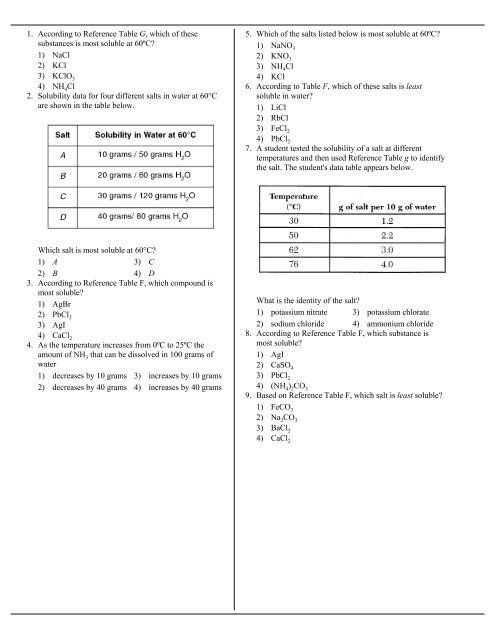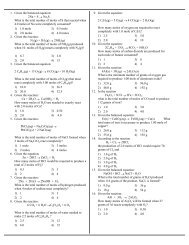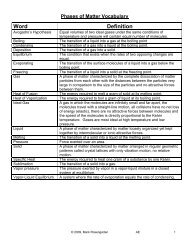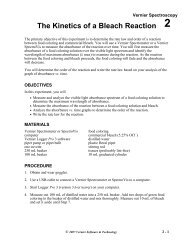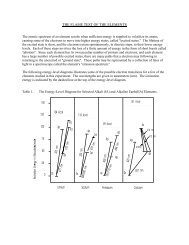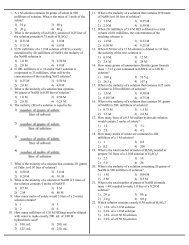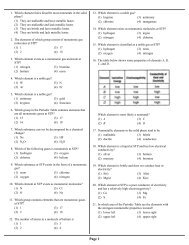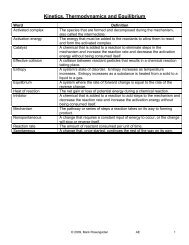Solubility - Revsworld
Solubility - Revsworld
Solubility - Revsworld
You also want an ePaper? Increase the reach of your titles
YUMPU automatically turns print PDFs into web optimized ePapers that Google loves.
1. According to Reference Table G, which of these<br />
substances is most soluble at 60ºC?<br />
1) NaCl<br />
2) KCl<br />
3) KClO 3<br />
4) NH 4 Cl<br />
2. <strong>Solubility</strong> data for four different salts in water at 60°C<br />
are shown in the table below.<br />
5. Which of the salts listed below is most soluble at 60ºC?<br />
1) NaNO 3<br />
2) KNO 3<br />
3) NH 4 Cl<br />
4) KCl<br />
6. According to Table F, which of these salts is least<br />
soluble in water?<br />
1) LiCl<br />
2) RbCl<br />
3) FeCl 2<br />
4) PbCl 2<br />
7. A student tested the solubility of a salt at different<br />
temperatures and then used Reference Table g to identify<br />
the salt. The student's data table appears below.<br />
Which salt is most soluble at 60°C?<br />
1) A 3) C<br />
2) B 4) D<br />
3. According to Reference Table F, which compound is<br />
most soluble?<br />
1) AgBr<br />
2) PbCl 2<br />
3) AgI<br />
4) CaCl 2<br />
4. As the temperature increases from 0ºC to 25ºC the<br />
amount of NH 3 that can be dissolved in 100 grams of<br />
water<br />
1) decreases by 10 grams 3) increases by 10 grams<br />
2) decreases by 40 grams 4) increases by 40 grams<br />
What is the identity of the salt?<br />
1) potassium nitrate 3) potassium chlorate<br />
2) sodium chloride 4) ammonium chloride<br />
8. According to Reference Table F, which substance is<br />
most soluble?<br />
1) AgI<br />
2) CaSO 4<br />
3) PbCl 2<br />
4) (NH 4 ) 2 CO 3<br />
9. Based on Reference Table F, which salt is least soluble?<br />
1) FeCO 3<br />
2) Na 2 CO 3<br />
3) BaCl 2<br />
4) CaCl 2
10. A student obtained the following data in determining the 12. Given the diagram below that shows carbon dioxide in<br />
solubility of a substance.<br />
an equilibrium system at a temperature of 298 K and a<br />
pressure of 1 atm:<br />
Which graph best represents the solubility curve drawn<br />
from the results obtained by the student?<br />
1)<br />
Which changes must increase the solubility of the carbon<br />
dioxide?<br />
1) increase pressure and decrease temperature<br />
2) increase pressure and increase temperature<br />
3) decrease pressure and decrease temperature<br />
4) decrease pressure and increase temperature<br />
13. A gas is most soluble in a liquid under conditions of<br />
1) high temperature and high pressure<br />
2) high temperature and low pressure<br />
2)<br />
3) low temperature and high pressure<br />
4) low temperature and low pressure<br />
14. Based on Reference Table G, which of the following<br />
substances is most soluble at 60ºC?<br />
1) NH 4 Cl<br />
2) KCl<br />
3) NaCl<br />
4) NH 3<br />
15. Which compound decreases in solubility as the<br />
3)<br />
temperature of the solution is increased from 10ºC to<br />
50ºC?<br />
1) NH 4 Cl<br />
2) NaCl<br />
3) NH 3<br />
4) NaNO 3<br />
16. The attraction between water molecules and an Na + ion<br />
or a Cl – ion occurs because water molecules are<br />
1) linear 3) polar<br />
4)<br />
2) symmetrical 4) nonpolar<br />
17. Based on Reference Table F, which of the following<br />
compounds is least soluble in water?<br />
1) NaCl<br />
2) Pb 2 ClO 3<br />
3) Na 2 CrO 4<br />
4) PbCrO 4<br />
18. The solubility of a salt in a given volume of water<br />
depends primarily on the<br />
11. According to Reference Table F, which of these<br />
1) surface area of the salt crystals<br />
compounds is most soluble at 298 K and 1 atm?<br />
2) temperature of the water<br />
1) PbCl 2<br />
3) rate at which the salt and water are stirred<br />
2) AgCl<br />
4) pressure on the surface of the water<br />
3) PbCrO 4<br />
4) PbCO 3
19. According to Reference Table G, which of the following<br />
substances is least soluble in 100 grams of water at 50ºC?<br />
1) NaCl 3) NH 4 Cl<br />
2) KCl 4) HCl<br />
20. The graph below represents four solubility curves.<br />
Which curve best represents the solubility of a gas in<br />
water?<br />
27. In an aqueous solution of potassium chloride, the solute is<br />
1) Cl<br />
2) K<br />
3) KCl<br />
4) H 2 O<br />
28. According to Reference Table G, how many grams of<br />
KNO 3 would be needed to saturate 200 grams of water at<br />
70ºC?<br />
1) 43 g 3) 134 g<br />
2) 86 g 4) 268 g<br />
29. A student determined the mass, in grams, of compound X<br />
that would saturate 30. grams of water over a<br />
temperature range of 40.ºC in 10.-degree intervals. The<br />
results are tabulated below.<br />
1) A 3) C<br />
2) B 4) D<br />
21. Which of the following compounds is least soluble in<br />
water?<br />
1) copper (II) chloride 3) iron (III) hydroxide<br />
2) aluminum acetate 4) potassium sulfate<br />
22. When PbI 2 (s) is added to Na 2 CO 3 (aq), a white precipitate<br />
is formed. According to Reference Table F, the white<br />
precipitate most likely is<br />
1) KNO 3<br />
2) PbCO 3<br />
3) NaI<br />
4) Na 2 CO 3<br />
23. A change in pressure would have the greatest effect on<br />
the solubility of a<br />
1) solid in a liquid 3) liquid in a liquid<br />
2) gas in a liquid 4) liquid in a solid<br />
24. Based on Reference Table F, which of the following<br />
saturated solutions would be the least concentrated?<br />
1) sodium sulfate 3) copper (II) sulfate<br />
2) potassium sulfate 4) barium sulfate<br />
25. Which compound is most soluble in water?<br />
1) silver acetate 3) silver nitrate<br />
2) silver chloride 4) silver sulfate<br />
26. As the pressure on a gas confined above a liquid<br />
increases, the solubility of the gas in the liquid<br />
1) decreases 3) remains the same<br />
2) increases<br />
If this solubility trend continues, what is the total number<br />
of grams of compound X that will dissolve in 30. grams<br />
of water at 60.ºC?<br />
1) 16 3) 48<br />
2) 32 4) 64<br />
30. At room temperature, the solubility of which solute in<br />
water would be most affected by a change in pressure?<br />
1) methanol 3) carbon dioxide<br />
2) sugar 4) sodium nitrate<br />
31. According to Reference Table F, which compound is<br />
most soluble in water?<br />
1) BaCO 3<br />
2) BaSO 4<br />
3) ZnCO 3<br />
4) ZnSO 4<br />
32. Based on Reference Table G, what change will cause the<br />
solubility of KNO 3 (s) to increase?<br />
1) decreasing the pressure<br />
2) increasing the pressure<br />
3) decreasing the temperature<br />
4) increasing the temperature<br />
33. According to the Reference Table G, which of the<br />
following substances is least soluble in 100 grams of H 2<br />
O(…) at 50ºC?<br />
1) KCl 3) NH 4 Cl<br />
2) NaCl 4) HCl<br />
34. Carbon dioxide gas is most soluble in water under<br />
conditions of<br />
1) high pressure and low temperature<br />
2) high pressure and high temperature<br />
3) low pressure and low temperature<br />
4) low pressure and high temperature
35. Based on Reference Table G, what is the maximum<br />
number of grams of KCl(s) that will dissolve in 200<br />
grams of water at 50°C to produce a saturated solution?<br />
1) 38 g 3) 58 g<br />
2) 42 g 4) 84 g<br />
36. Which salt has the greatest change in solubility between<br />
30ºC and 50ºC?<br />
1) KNO 3 3) NaNO 3<br />
2) KCl 4) NaCl<br />
37. According to Reference Table G, which compound's<br />
solubility decreases most rapidly when the temperature<br />
increases from 50ºC to 70ºC?<br />
1) NH 3<br />
2) HCl<br />
3) SO 2<br />
4) KNO 3<br />
38. A 2.00-liter sample of a gas has a mass of 1.80 grams at<br />
STP. What is the density, in grams per liter, of this gas at<br />
STP?<br />
1) 0.900 3) 11.2<br />
2) 1.80 4) 22.4<br />
39. A student obtained the following data in a chemistry<br />
laboratory.<br />
Based on Reference Table g, which of the trials seems to<br />
be in error?<br />
1) 1 3) 3<br />
2) 2 4) 4<br />
40. According to Reference Table G, how does a decrease in<br />
temperature from 40°C to 20°C affect the solubility of<br />
NH 3 and KCl?<br />
1) The solubility of NH 3 decreases, and the<br />
solubility of KCl decreases.<br />
2) The solubility of NH 3 decreases, and the<br />
solubility of KCl increases.<br />
3) The solubility of NH 3 increases, and the<br />
solubility of KCl decreases.<br />
4) The solubility of NH 3 increases, and the<br />
solubility of KCl increases.<br />
41. Based on Reference Table G, which of the following<br />
substances is most soluble at 50°C?<br />
1) KClO 3<br />
2) NH 3<br />
3) NaCl<br />
4) NH 4 Cl<br />
42. At which temperature can water contain the most<br />
dissolved oxygen at a pressure of 1 atmosphere?<br />
1) 10.ºC 3) 30.ºC<br />
2) 20.ºC 4) 40.ºC<br />
43. According to Reference Table G, what is the<br />
approximate difference between the amounts of KClO 3<br />
and KNO 3 soluble in 100 grams of water at 40ºC?<br />
1) 17 g 3) 47 g<br />
2) 22 g 4) 64 g<br />
44. At STP, which of these substances is most soluble in H 2<br />
O?<br />
1) CCl 4<br />
2) CO 2<br />
3) HCl<br />
4) N 2<br />
45. Which compound is least soluble in 100 grams of water<br />
at 40°C?<br />
1) SO 2<br />
2) NaCl<br />
3) KClO 3<br />
4) NH 4 Cl<br />
46. According to Reference Table G, a temperature change<br />
from 10°C to 30°C would have the least effect on the<br />
solubility of<br />
1) NaCl<br />
2) KClO 3<br />
3) NH 3<br />
4) SO 2
Reference Tables
Reference Tables
Reference Tables
Reference Tables
Answer Key<br />
1. 4<br />
2. 4<br />
3. 4<br />
4. 2<br />
5. 1<br />
6. 4<br />
7. 3<br />
8. 4<br />
9. 1<br />
10. 1<br />
11. 2<br />
12. 1<br />
13. 3<br />
14. 1<br />
15. 3<br />
16. 3<br />
17. 4<br />
30. 3<br />
31. 4<br />
32. 4<br />
33. 2<br />
34. 1<br />
35. 4<br />
36. 1<br />
37. 1<br />
38. 1<br />
39. 4<br />
40. 3<br />
41. 4<br />
42. 1<br />
43. 3<br />
44. 3<br />
45. 1<br />
46. 1<br />
18. 2<br />
19. 1<br />
20. 2<br />
21. 3<br />
22. 2<br />
23. 2<br />
24. 4<br />
25. 3<br />
26. 2<br />
27. 3<br />
28. 4<br />
29. 4


